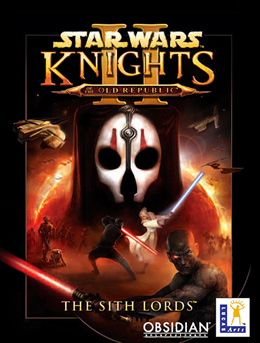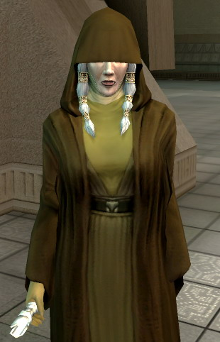Related Research Articles
Video game modding is the process of alteration by players or fans of one or more aspects of a video game, such as how it looks or behaves, and is a sub-discipline of general modding. Mods may range from small changes and tweaks to complete overhauls, and can extend the replay value and interest of the game.

Star Wars: Knights of the Old Republic is a role-playing video game developed by BioWare and published by LucasArts. The first installment of the Star Wars: Knights of the Old Republic series, it was released for the Xbox on July 16, 2003, and for Microsoft Windows on November 19, 2003. It was ported to Mac OS X, iOS, and Android by Aspyr, and it is playable on the Xbox 360, Xbox One, and Xbox Series X and Series S via backward compatibility. A Nintendo Switch version was released on November 11, 2021.
Obsidian Entertainment, Inc. is an American video game developer based in Irvine, California. It was founded in June 2003, shortly before the closure of Black Isle Studios, by ex-Black Isle employees Feargus Urquhart, Chris Avellone, Chris Parker, Darren Monahan, and Chris Jones.

Star Wars Knights of the Old Republic II: The Sith Lords is a role-playing video game developed by Obsidian Entertainment and published by LucasArts. It is the sequel to BioWare's Star Wars: Knights of the Old Republic and was released for the Xbox on December 6, 2004, for Microsoft Windows on February 8, 2005, for OS X and Linux on July 21, 2015, for Android and iOS on December 18, 2020 and for Nintendo Switch on June 8, 2022. Like its predecessor, it is set in the Star Wars universe 4,000 years before the events of the film Episode I: The Phantom Menace and is based on the d20 System developed by Wizards of the Coast.

Kreia is a character and party member in Obsidian Entertainment's Star Wars Knights of the Old Republic II: The Sith Lords. She is a blind Force-sensitive who forms a "bond" with the player character, the Jedi Exile, through the Force. Kreia sets herself up as the Exile's mentor, and rejects the divide of the light and dark side of the Force, as well as the predestination the Force entails. By the game's end, it is revealed she is the Sith Lord Darth Traya and is planning on destroying the Force, and she becomes the final boss of The Sith Lords. Kreia makes no more appearances in Star Wars fiction, though a miniature by Wizards of the Coast was released in August 2008, and she appears as an obtainable character in Star Wars: Galaxy of Heroes.

Aspyr Media, Inc. is an American video game developer and publisher founded by Michael Rogers and Ted Staloch in Austin, Texas. Originally founded to bring top gaming titles to macOS, the company, since 2005, has become a publisher and developer of entertainment for multiple gaming platforms.

Neverwinter Nights 2 is a role-playing video game developed by Obsidian Entertainment and published by Atari Interactive. It is the second installment in the Neverwinter Nights series and is the sequel to BioWare's Neverwinter Nights, based on the Dungeons & Dragons fantasy tabletop role-playing game. Neverwinter Nights 2 utilizes an adaptation of the Dungeons & Dragons 3.5 edition rules. Players create player characters to represent themselves in the game, using the same character creation rules as found in the Dungeons & Dragons game. They may gain the assistance of additional party members, and they eventually acquire a keep that can be used as a base of operations. Neverwinter Nights 2 is set in the Forgotten Realms campaign setting—in and around the city of Neverwinter. The story is mostly unrelated to Neverwinter Nights and follows the journey of an orphaned adventurer investigating a group of mysterious artifacts known as "silver shards" and their connection to an ancient, evil spirit known as the King of Shadows.

Freedom Force vs the 3rd Reich is a real-time tactical role-playing game developed and published by Irrational Games. The sequel to Freedom Force, the player guides a team of superheroes as they travel back in time, and help overthrow Nazi Germany and its allies during World War II. In the game, players take control of a team of up to four characters and battle their way through completely destructible 3D maps in a series of missions based on classic superhero comics.

"Hot Coffee" is the unofficial name for a minigame in the 2004 action-adventure video game Grand Theft Auto: San Andreas by Rockstar Games. While it was not playable in the official game release, the modding community discovered hidden code that, when enabled, allows protagonist Carl "CJ" Johnson to have animated sexual intercourse with his in-game girlfriend.

Joshua Eric Sawyer, more commonly known and credited as Josh Sawyer, J.E. Sawyer, or JSawyer, is an American video game designer, known for his work on role-playing video games.

The video games Star Wars: Knights of the Old Republic (2003) and Star Wars Knights of the Old Republic II: The Sith Lords (2004) features a large cast of characters noted for its diversity and is the subject of significant discussion from gaming magazines and websites.

Star Wars: Knights of the Old Republic (KOTOR) is a media franchise of space western role-playing video games created and developed by BioWare, which have seen releases on the original Xbox, Xbox 360, Microsoft Windows, OS X, Xbox One, Xbox Series X/S, IOS and Android. The franchise takes place in the fictional universe of Star Wars by George Lucas.

Fallout: New Vegas is a 2010 action role-playing game developed by Obsidian Entertainment and published by Bethesda Softworks. It was announced in April 2009 and released for PlayStation 3, Windows, and Xbox 360 on October 19, 2010. A spin-off of the main Fallout series, the game is set in a post-apocalyptic open-world environment that encompasses a region consisting of parts of Arizona, California, and Nevada. It is set in a world that deviated onto an alternate timeline thanks to Atomic Age technology, which eventually led to a global nuclear apocalypse in the year 2077 in an event referred to as "The Great War", caused by a major conflict between the U.S. and China over natural resources. The main story of New Vegas takes place in the year 2281, four years after the events of Fallout 3 and 204 years after the bombs fell. It is not a sequel but does feature the return of several elements found in Fallout 2.
An unofficial patch is a patch for a piece of software, created by a third party such as a user community without the involvement of the original developer. Similar to an ordinary patch, it alleviates bugs or shortcomings. Unofficial patches do not usually change the intended usage of the software, in contrast to other third-party software adaptions such as mods or cracks.

Skyforge is a free-to-play massively multiplayer online role-playing game developed by Allods Team in collaboration with Obsidian Entertainment, and published by My.com. Set on the planet Aelion, Skyforge fuses elements of Science fiction and fantasy in its visuals and storytelling, and sees players exploring the world as an immortal who must strive to become a god and defend the planet from alien invasion from other worlds. The project started development in 2010 and received an open release for Microsoft Windows in July 2015, with PlayStation 4 and Xbox One releases following in 2017. The latest major content update, "Ignition", was released on all platforms in September 2019. A Nintendo Switch version was released in February 2021.

User modification, or modding, of video games in the open world sandbox Grand Theft Auto series is a popular trend in the PC gaming community. These unofficial modifications are made by altering gameplay logic and asset files within a user's game installation, and can change the player's experience to varying degrees. Frequently created by anonymous modders, modifications are presented in the form of downloadable files or archives. Third-party software has been indispensable for building Grand Theft Auto mods, due to the lack of official editing tools from the developer, Rockstar Games. Mods for Grand Theft Auto are generally developed for use on the PC versions of the games, since the platform does not prevent modifications to installed software; however, similar content for console and mobile phone versions does exist to an extent.
A Minecraft mod is a mod that changes aspects of the sandbox game Minecraft. Minecraft mods can add additional content to the game, make tweaks to specific features, and optimize performance. Thousands of mods for the game have been created, with some mods even generating an income for their authors. While Mojang Studios does not provide an API for modding, community tools exist to help developers create and distribute mods. The popularity of Minecraft mods has been credited for helping Minecraft become one of the best-selling video games of all time.
Based on Id Software's open stance towards game modifications, their Quake series became a popular subject for player mods beginning with Quake in 1996. Spurred by user-created hacked content on their previous games and the company's desire to encourage the hacker ethic, Id included dedicated modification tools into Quake, including the QuakeC programming language and a level editor. As a game that popularized online first-person shooter multiplayer, early games were team- and strategy-based and led to prominent mods like Team Fortress, whose developers were later hired by Valve to create a dedicated version for the company. Id's openness and modding tools led to a "Quake movie" community, which altered gameplay data to add camera angles in post-production, a practice that became known as machinima.
Skyrimmodding refers to the community-made modifications for the 2011 fantasy role-playing video game The Elder Scrolls V: Skyrim. One of the most modded video games of all time, it has nearly 70,000 mod submissions on Nexus Mods and 28,000 in the Steam Workshop. Many of these mods were created for utility reasons, patching numerous bugs left in the game by Bethesda Softworks, while also improving the game's usability and character movement. Other mods add new quests and characters, or update the game's graphics and animations. As the vanilla game has a reputation for outdated mechanics, it is common for players to mod Skyrim even prior to their first playthrough.
Playbour is a hybrid form of play and labour, specifically in the digital games industry.
References
- 1 2 Schreier, Jason (December 17, 2012). "The Knights of New Vegas". Kotaku . Archived from the original on November 22, 2018. Retrieved June 16, 2015.
- 1 2 3 4 5 6 7 8 9 10 11 12 13 14 15 16 17 18 Luke Winkie (September 18, 2015). "Modding the Sith Lords: How Fans Salvaged KOTOR 2". Paste Magazine. Archived from the original on October 9, 2020. Retrieved October 16, 2020.
- 1 2 3 Matthew Byrd (April 4, 2018). "Star Wars: How Knights of the Old Republic II Became Gaming's Great Unfinished Symphony". Den of Geek. Archived from the original on October 11, 2020. Retrieved October 16, 2020.
- ↑ Phil Owen (May 30, 2014). "Why Star Wars: Knights of the Old Republic 2 Is Better Than The Original". Kotaku . Archived from the original on September 21, 2020. Retrieved October 16, 2020.
- 1 2 3 Andrew Tsai (January 3, 2013). "The Fixer: How To Restore Knights of the Old Republic II". Rock Paper Shotgun . Archived from the original on August 14, 2021. Retrieved August 26, 2021.
- 1 2 3 4 Robert Purchese (September 29, 2009). "KOTOR2 missing content restored". Eurogamer. Archived from the original on August 27, 2021. Retrieved August 26, 2021.
- 1 2 3 4 5 6 7 8 9 10 11 12 13 14 15 16 17 18 Tyler Wilde (July 26, 2012). "Community heroes: modders debug and restore cut content in Knights of the Old Republic II". PC Gamer. Archived from the original on August 14, 2021. Retrieved August 26, 2021.
- 1 2 3 Jared Nelson (December 18, 2020). "'Star Wars KOTOR 2' Now Available on iOS and Confirmed to Work with the Restored Content Mod". TouchArcade . Archived from the original on September 18, 2021. Retrieved August 26, 2021.
- 1 2 3 4 Jen Rothery (March 4, 2020). "Revisiting the KotOR 2 companion I was in love with 15 years later". PCGamesN . Archived from the original on October 12, 2020. Retrieved October 16, 2020.
- 1 2 3 William Hughes (April 27, 2016). "In games, you can't—and shouldn't—win them all". The A.V. Club . Archived from the original on October 8, 2020. Retrieved October 16, 2020.
- 1 2 3 4 5 6 7 Chris J Capel (August 3, 2019). "KOTOR 2 gets a massive AI-enhanced HD texture mod". PCGamesN . Archived from the original on June 11, 2021. Retrieved June 10, 2021.
- 1 2 3 4 5 Austin Taylor (December 6, 2019). "The modders who spent 15 years fixing Knights of the Old Republic 2". Ars Technica . Archived from the original on June 11, 2021. Retrieved June 10, 2021.
- 1 2 3 4 5 6 7 8 9 Francis, Bryant (July 29, 2015). "How a ragtag band of modders restored Star Wars KOTOR II Exclusive". Gamasutra . Archived from the original on August 26, 2021. Retrieved August 26, 2021.
- 1 2 Purchese, Robert (October 16, 2015). "Star Wars: Knights of the Old Republic 2 gets a surprise, huge patch". Eurogamer . Archived from the original on August 26, 2021. Retrieved August 26, 2021.
- ↑ @AustinGMalcolm (May 27, 2022). "Nope, free!" (Tweet) – via Twitter.
- ↑ @AspyrMedia (June 3, 2023). "Update on the Restored Content DLC" (Tweet) – via Twitter.
- ↑ "Player's Choice 2014 Awards". 30 December 2014. Archived from the original on 2015-05-13. Retrieved 2021-09-05.
- 1 2 3 Robert Purchese (31 July 2013). "Fear is the path to the dark side". Eurogamer . Archived from the original on 22 June 2015. Retrieved 30 July 2015.
- 1 2 Robert Purchese (July 29, 2015). "Now it's got Steam Workshop support, is Knights of the Old Republic 2 worth returning to?". Eurogamer. Archived from the original on October 8, 2020. Retrieved October 16, 2020.
- ↑ Nathan Grayson (July 21, 2015). "Ten Years Later, Star Wars KOTOR II Gets An Official Update". Kotaku . Archived from the original on September 23, 2021. Retrieved August 26, 2021.